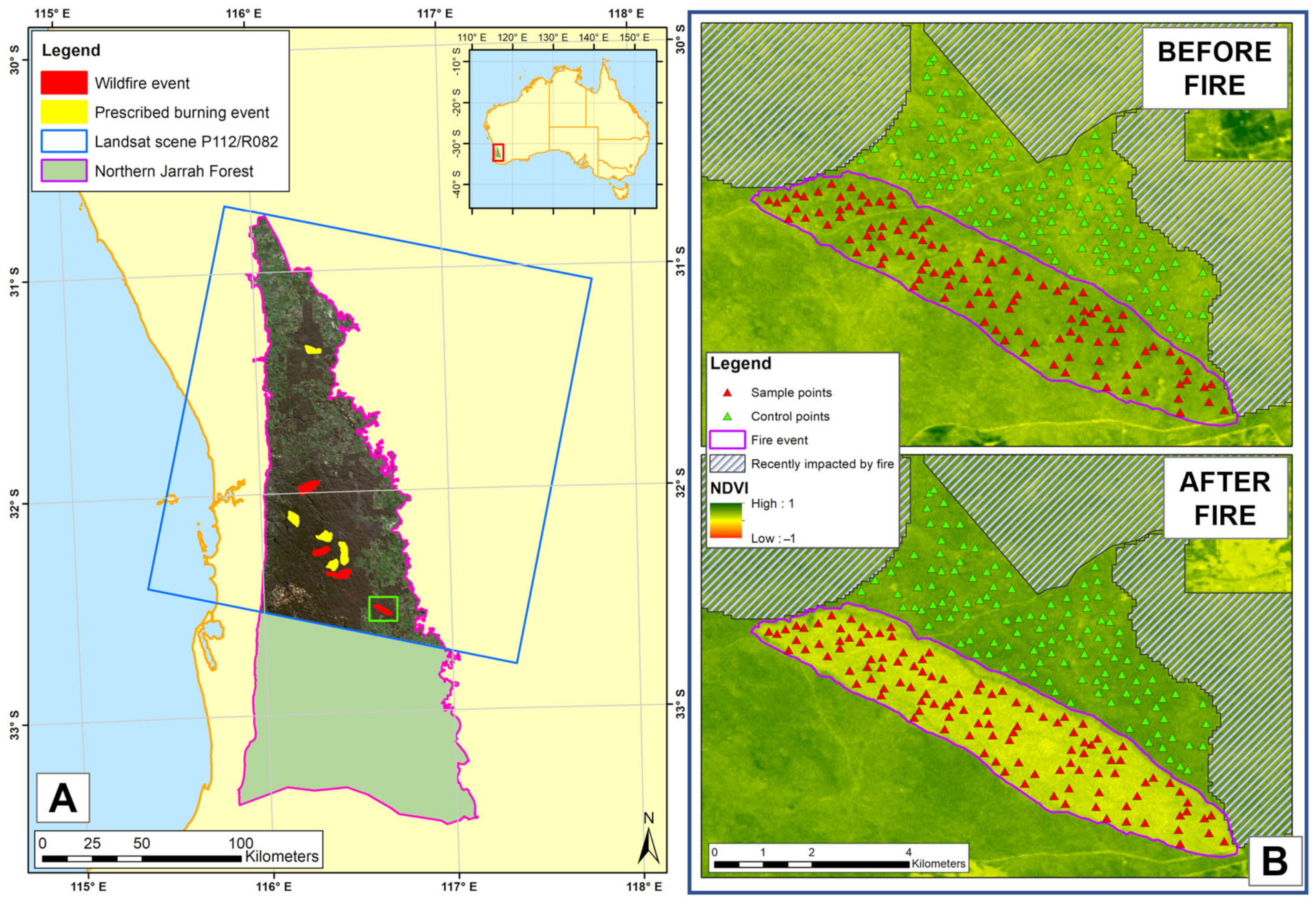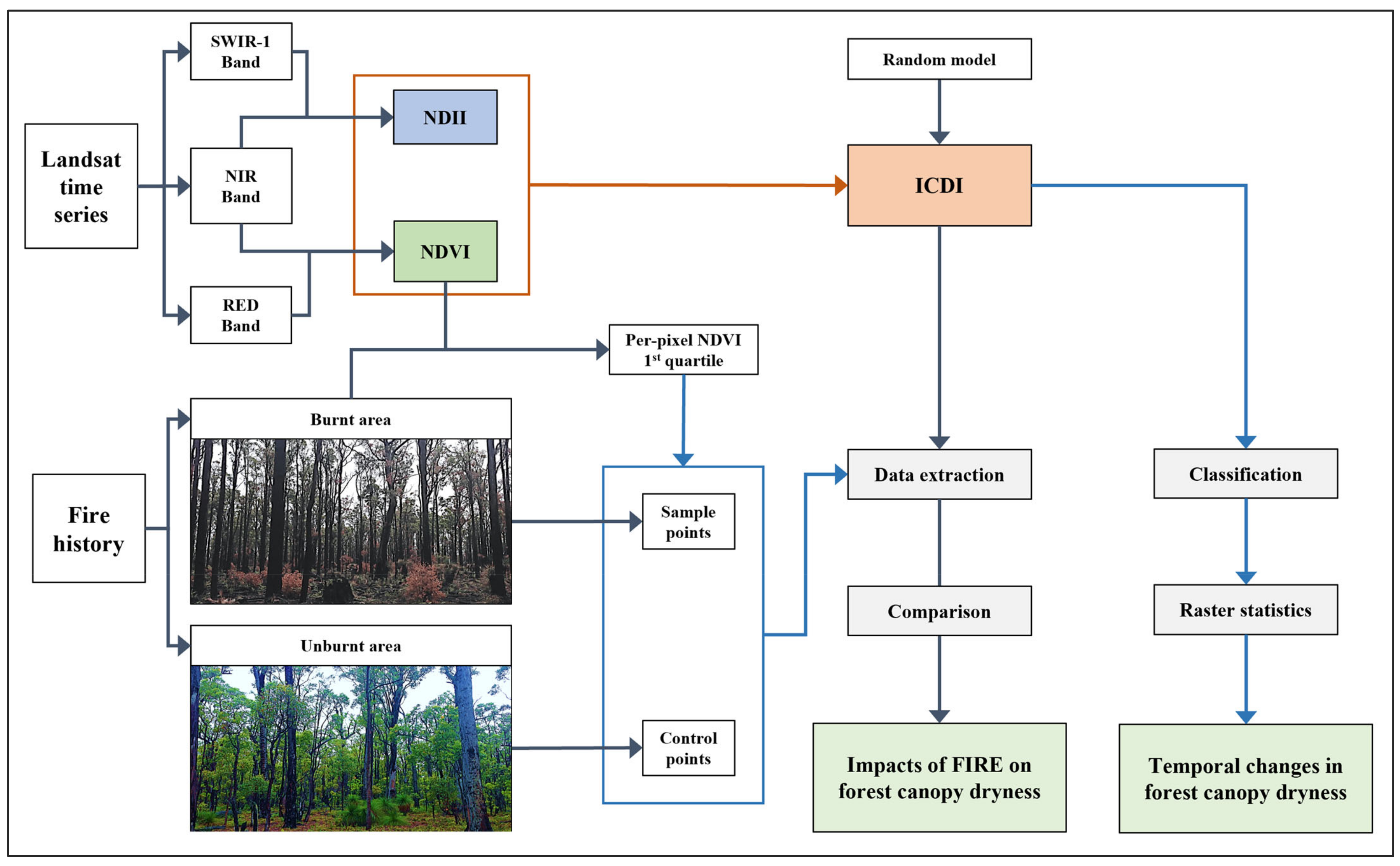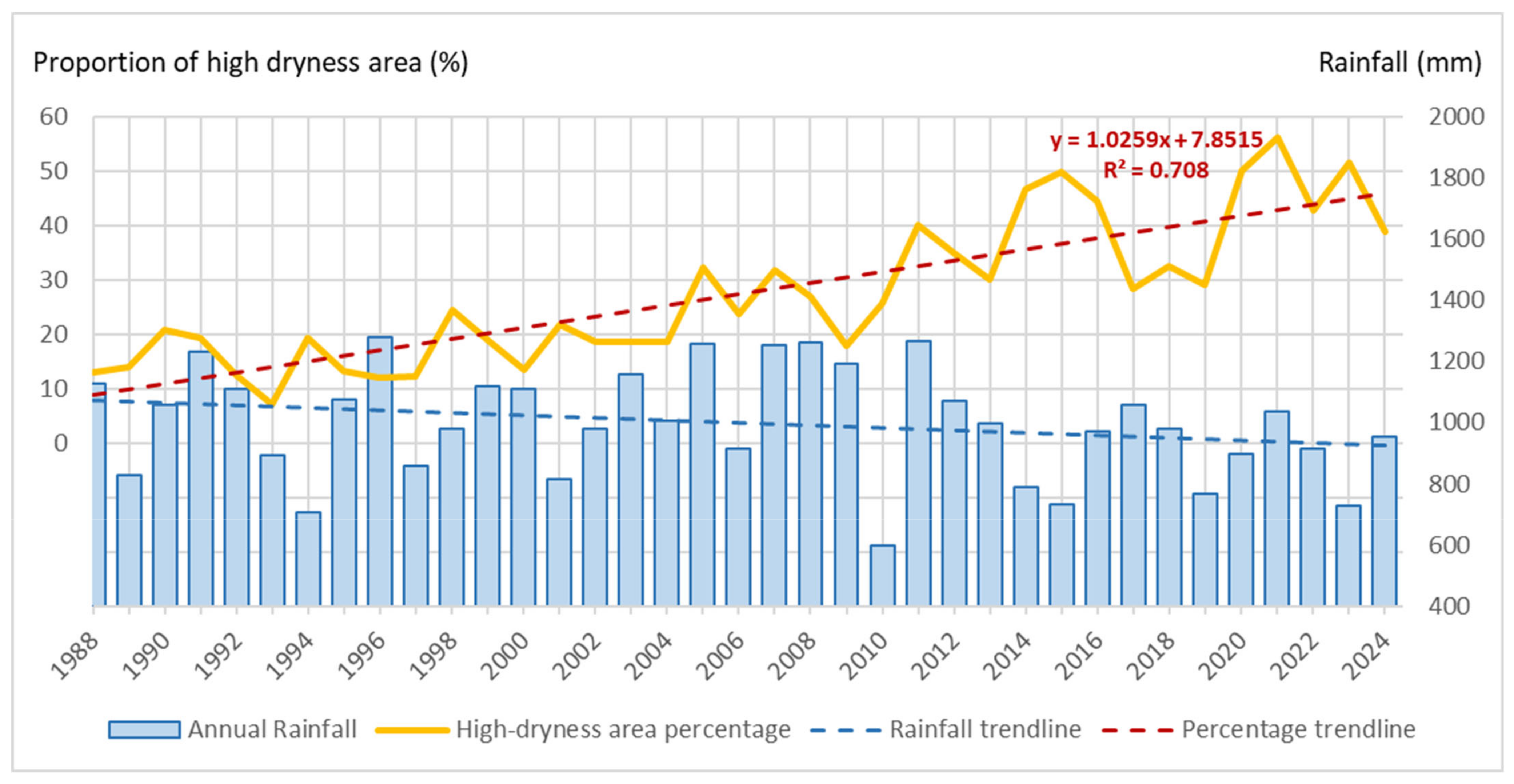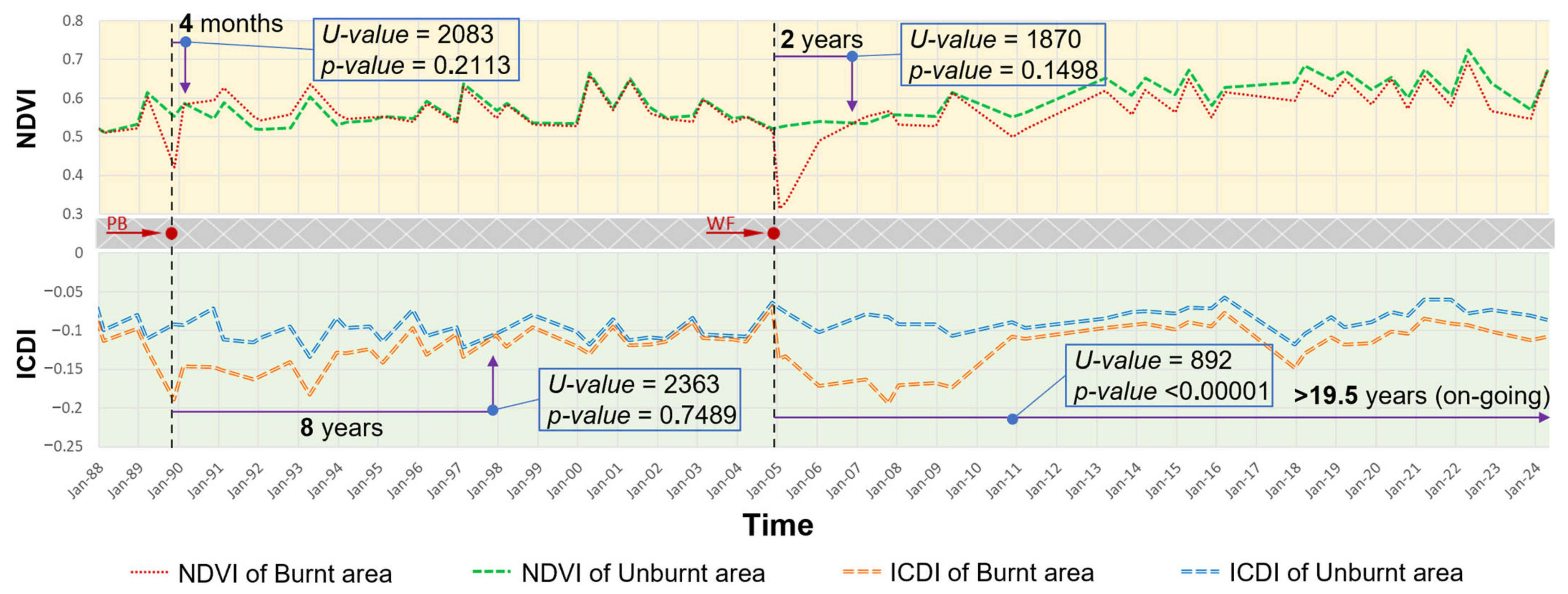Remote-Sensed Evidence of Fire Alleviating Forest Canopy Water Stress Under a Drying Climate
Abstract
1. Introduction
2. Materials and Methods
2.1. Study Location
2.2. Data Sources
2.2.1. Remotely Sensed Data
2.2.2. Fire History and Control Unburnt Data
2.3. Analysis
2.3.1. Data Pre-Processing
2.3.2. Data Processing
2.3.3. Changes in Forest Canopy Dryness over Time
2.3.4. Exploring Prolonged Effects of Fire on Canopy Water Stress
3. Results
3.1. Canopy Dryness in the Northern NJF from 1987 to 2024
3.2. Cover and Dryness of Burnt and Unburnt Forests
4. Discussion
4.1. ICDI Application for Forest Water Stress Monitoring
4.2. Prescribed Burning—Water Stress Relief Under Climate Change
5. Conclusions
Author Contributions
Funding
Data Availability Statement
Acknowledgments
Conflicts of Interest
References
- Pekin, B.K.; Boer, M.M.; Macfarlane, C.; Grierson, P.F. Impacts of increased fire frequency and aridity on eucalypt forest structure, biomass and composition in southwest Australia. For. Ecol. Manag. 2009, 258, 2136–2142. [Google Scholar] [CrossRef]
- Moazeni, S.; Cerdà, A. The impacts of forest fires on watershed hydrological response. A review. Trees For. People 2024, 18, 10. [Google Scholar] [CrossRef]
- De Luis, M.; González-Hidalgo, J.C.; Raventós, J. Effects of fire and torrential rainfall on erosion in a Mediterranean gorse community. Land. Degrad. Dev. 2003, 14, 203–213. [Google Scholar] [CrossRef]
- Wasserman, T.N.; Mueller, S.E. Climate influences on future fire severity: A synthesis of climate-fire interactions and impacts on fire regimes, high-severity fire, and forests in the western United States. Fire Ecol. 2023, 19, 43. [Google Scholar] [CrossRef]
- Yin, J.; He, B.; Fan, C.; Chen, R.; Zhang, H.; Zhang, Y. Drought-related wildfire accounts for one-third of the forest wildfires in subtropical China. Agric. For. Meteorol. 2024, 346, 109893. [Google Scholar] [CrossRef]
- Xing, H.; Fang, K.; Yao, Q.; Zhou, F.; Ou, T.; Liu, J.; Zhou, S.; Jiang, S.; Chen, Y.; Bai, M.; et al. Impacts of changes in climate extremes on wildfire occurrences in China. Ecol. Indic. 2023, 157, 111288. [Google Scholar] [CrossRef]
- Gajendiran, K.; Kandasamy, S.; Narayanan, M. Influences of wildfire on the forest ecosystem and climate change: A comprehensive study. Environ. Res. 2024, 240, 117537. [Google Scholar] [CrossRef]
- Nieman, W.A.; Wilgen, B.W.v.; Leslie, A.J. A review of fire management practices in African savanna-protected areas. Koedoe-Afr. Prot. Area Conserv. Sci. 2021, 63, 160. [Google Scholar] [CrossRef]
- Williams, J.N.; Quinn-Davidson, L.; Safford, H.D.; Grupenhoff, A.; Middleton, B.R.; Restaino, J.; Smith, E.; Adlam, C.; Rivera-Huerta, H. Overcoming obstacles to prescribed fire in the North American Mediterranean climate zone. Front. Ecol. Environ. 2023, 22, e2687. [Google Scholar] [CrossRef]
- Valkó, O.; Deák, B. Increasing the potential of prescribed burning for the biodiversity conservation of European grasslands. Curr. Opin. Environ. Sci. Health 2021, 22, 100268. [Google Scholar] [CrossRef]
- Morgan, G.W.; Tolhurst, K.G.; Poynter, M.W.; Cooper, N.; McGuffog, T.; Ryan, R.; Wouters, M.A.; Stephens, N.; Black, P.; Sheehan, D.; et al. Prescribed burning in south-eastern Australia: History and future directions. Aust. For. 2020, 83, 4–28. [Google Scholar] [CrossRef]
- Gharun, M.; Possell, M.; Vervoort, R.W.; Adams, M.A.; Bell, T.L. Can a growth model be used to describe forest carbon and water balance after fuel reduction burning in temperate forests? Sci. Total Environ. 2018, 615, 1000–1009. [Google Scholar] [CrossRef] [PubMed]
- Soulis, K.X.; Generali, K.A.; Papadaki, C.; Theodoropoulos, C.; Psomiadis, E. Hydrological Response of Natural Mediterranean Watersheds to Forest Fires. Hydrology 2021, 8, 15. [Google Scholar] [CrossRef]
- Giuditta, E.; Coenders-Gerrits, A.M.J.; Bogaard, T.A.; Wenninger, J.; Greco, R.; Rutigliano, F.A. Measuring changes in forest floor evaporation after prescribed burning in Southern Italy pine plantations. Agric. For. Meteorol. 2018, 256–257, 516–525. [Google Scholar] [CrossRef]
- Rulli, M.C.; Rosso, R. Hydrologic response of upland catchments to wildfires. Adv. Water Resour. 2007, 30, 2072–2086. [Google Scholar] [CrossRef]
- Poon, P.K.; Kinoshita, A.M. Spatial and temporal evapotranspiration trends after wildfire in semi-arid landscapes. J. Hydrol. 2018, 559, 71–83. [Google Scholar] [CrossRef]
- Pereira, M.G.; Fernandes, L.S.; Carvalho, S.; Santos, R.B.; Caramelo, L.; Alencoão, A. Modelling the impacts of wildfires on runoff at the river basin ecological scale in a changing Mediterranean environment. Environ. Earth Sci. 2016, 75, 392. [Google Scholar] [CrossRef]
- Robichaud, P.R. Fire Effects on Infiltration Rates after Prescribed Fire in Northern Rocky Mountain Forests, USA. J. Hydrol. 2000, 231, 220–229. [Google Scholar] [CrossRef]
- Zhou, Y.; Zhang, Y.; Vaze, J.; Lane, P.; Xu, S. Impact of bushfire and climate variability on streamflow from forested catchments in southeast Australia. Hydrol. Sci. J. 2015, 60, 1340–1360. [Google Scholar] [CrossRef]
- Mayor, A.G.; Bautista, S.; Llovet, J.; Bellot, J. Post-fire hydrological and erosional responses of a Mediterranean landscpe: Seven years of catchment-scale dynamics. CATENA 2007, 71, 68–75. [Google Scholar] [CrossRef]
- Vega, J.A.; Fernández, C.; Fonturbel, T. Throughfall, runoff and soil erosion after prescribed burning in gorse shrubland in Galicia (NW Spain). Land. Degrad. Dev. 2005, 16, 37–51. [Google Scholar] [CrossRef]
- Marcos, E.; Tarrega, R.; Luis-Calabuig, E. Comparative Analysis of Runo and Sediment Yield with a Rainfall Simulator After Experimental Fire. Arid Soil Res. Rehabil. 2010, 14, 293–307. [Google Scholar] [CrossRef]
- Inbar, M.; Tamir, M.; Wittenberg, L. Runoff and erosion processes after a forest fire in Mount Carmel, a Mediterranean area. Geomorphology 1998, 24, 17–33. [Google Scholar] [CrossRef]
- Bell, D.; McCaw, W.; Burrows, N. Influence of fire on jarrah forest vegetation. In Jarrah Forest, A Complex Mediterranean Ecosystem; Dell, B., Havel, J.J., Malajczuk, N., Eds.; Kluwer Academic Publisher: Dordrecht, The Netherlands, 1989. [Google Scholar]
- Hood, S.M.; Keyes, C.R.; Bowen, K.J.; Lutes, D.C.; Seielstad, C. Fuel treatment longevity in ponderosa pine-dominated forest 24 years after cutting and prescribed burning. Front. For. Glob. Change 2020, 3, 78. [Google Scholar] [CrossRef]
- Gentilli, J. Climate of the jarrah forest. In The Jarrah Forest, A Complex Mediterranean Ecosystem; Dell, B., Havel, J.J., Malajczuk, N., Eds.; Kluwer Academic Publisher: Dordrecht, The Netherlands, 1989. [Google Scholar]
- Hardy, G.; Matusick, G.; Ruthrof, K. Impacts of large scale drought deaths in Western Australia’s Northern Jarrah (Eucalyptus marginata) Forest. In Proceedings of the Ecological Society of Australia, Annual Conference, Melbourne, Australia, 19–21 June 2012. [Google Scholar]
- Croton, J.T.; Dalton, G.T.; Green, K.A.; Mauger, G.W.; Dalton, J.A. Northern Jarrah Forest Water-Balance Study to Inform the Review of Silviculture Guidelines; Technical Report No. 9; Forest and Ecosystem Management Division, Department of Parks and Wildlife: Perth, WA, Australia, 2014. [Google Scholar]
- Liu, N.; Harper, R.J.; Smettem, K.R.J.; Dell, B.; Liu, S. Responses of streamflow to vegetation and climate change in southwestern Australia. J. Hydrol. 2019, 572, 761–770. [Google Scholar] [CrossRef]
- Allen, C.D.; Macalady, A.K.; Chenchouni, H.; Bachelet, D.; McDowell, N.; Vennetier, M.; Kitzberger, T.; Rigling, A.; Breshears, D.D.; Hogg, E.H.T.; et al. A global overview of drought and heat-induced tree mortality reveals emerging climate change risks for forests. For. Ecol. Manag. 2010, 259, 660–684. [Google Scholar] [CrossRef]
- Trenberth, K.E.; Dai, A.; Van Der Schrier, G.; Jones, P.D.; Barichivich, J.; Briffa, K.R.; Sheffield, J. Global warming and changes in drought. Nat. Clim. Change 2014, 4, 17–22. [Google Scholar] [CrossRef]
- Cook, B.I.; Mankin, J.S.; Anchukaitis, K.J. Climate change and drought: From past to future. Curr. Clim. Change Rep. 2015, 4, 164–179. [Google Scholar] [CrossRef]
- Cholet, C.; Houle, D.; Sylvain, J.-D.; Doyon, F.; Maheu, A. Climate change increases the severity and duration of soil water stress in the temperate forest of eastern north America. Front. For. Glob. Change 2022, 5, 13. [Google Scholar] [CrossRef]
- Matusick, G.; Ruthrof, K.X.; Brouwers, N.C.; Dell, B.; Hardy, G.S.J. Sudden forest canopy collapse corresponding with extreme drought and heat in a mediterranean-type eucalypt forest in southwestern Australia. Eur. J. For. Res. 2013, 132, 497–510. [Google Scholar] [CrossRef]
- Burrows, N.; McCaw, L. Prescribed burning in southwestern Australian forests. Front. Ecol. Environ. 2013, 11, e25–e34. [Google Scholar] [CrossRef]
- McCaw, W.L.; Burrows, N.D. Fire management. In The Jarrah Forest—A Complex Mediterranean Ecosystem; Dell, B., Havel, J.J., Malajczuk, N., Eds.; Kluwer Academic Publishers: Dordrecht, The Netherlands, 1989; pp. 317–334. [Google Scholar]
- Fernandes, P.M.; Davies, G.M.; Ascoli, D.; Fernández, C.; Moreira, F.; Rigolot, E.; Stoof, C.R.; Vega, J.A.; Molina, D. Prescribed burning in southern Europe: Developing fire management in a dynamic landscape. Front. Ecol. Environ. 2013, 11, 4–14. [Google Scholar] [CrossRef]
- Weir, J.R.; Scasta, J.D. Global Application of Prescribed Fire; CSIRO Publishing: Clayton, Australia, 2022. [Google Scholar]
- Abbott, I.; Dell, B.; Loneragan, O. The jarrah plant. In The Jarrah Forest: A Complex Mediterranean Ecosystem; Dell, B., Havel, J.J., Malajczuk, N., Eds.; Kluwer Academic Publishers: Dordrecht, The Netherlands, 1989; pp. 41–51. [Google Scholar]
- Abbott, I.; Loneragan, O. Ecology of Jarrah (Eucalyptus marginata) in the Northern Jarrah Forest of Western Australia; Department of Conservation and Land Management: Perth, WA, Australia, 1986; p. 137. [Google Scholar]
- Schofield, N.J.; Stoneman, G.L.; Loh, I.C. Hydrology of the jarrah forest. In The Jarrah Forest: A Complex Mediterranean Ecosystem; Dell, B., Havel, J.J., Malajczuk, N., Eds.; Kluwer Academic Publishers: Dordrecht, The Netherlands, 1989; pp. 179–201. [Google Scholar]
- Matusick, G.; Ruthrof, K.X.; Kala, J.; Brouwers, N.C.; Breshears, D.D.; Hardy, G. Chronic historical drought legacy exacerbates tree mortality and crown dieback during acute heatwave-compounded drought. Environ. Res. Lett. 2018, 13, 095002. [Google Scholar] [CrossRef]
- Bradford, J.B.; Shriver, R.K.; Robles, M.D.; McCauley, L.A.; Woolley, T.J.; Andrews, C.A.; Crimmins, M.; Bell, D.M. Tree mortality response to drought-density interactions suggests opportunities to enhance drought resistance. J. Appl. Ecol. 2022, 59, 549–559. [Google Scholar] [CrossRef]
- Walden, L.L.; Fontaine, J.B.; Ruthrof, K.X.; Matusick, G.; Harper, R.J. Drought then wildfire reveals a compound disturbance in a resprouting forest. Ecol. Appl. 2023, 33, e2775. [Google Scholar] [CrossRef]
- Jackson, R.D. Canopy temperature and crop water stress. Adv. Irrig. 1982, 1, 43–85. [Google Scholar] [CrossRef]
- Korner, C. Humidity responses in forest trees: Precautions in thermal scanning surveys. Arch. Meteorol. Geophys. Bioclimatol. B 1985, 36, 83–96. [Google Scholar] [CrossRef]
- Fuchs, M. Infrared measurement of canopy temperature and detection of plant water stress. Theor. Appl. Climatol. 1990, 42, 253–261. [Google Scholar] [CrossRef]
- Le, T.S.; Harper, R.; Dell, B. Application of remote sensing in detecting and monitoring water stress in forests. Remote Sens. 2023, 15, 3360. [Google Scholar] [CrossRef]
- Carbon, B.A.; Bartle, G.A.; Murry, A.M. Water stress, transpiration and leaf area index in eucalypt plantations in a bauxite mining area in south-west Australia. Aust. J. Ecol. 1981, 6, 459–466. [Google Scholar] [CrossRef]
- Su, L.; Yang, J.; Zhao, X.; Miao, Y. Effects of fire on interception loss in a coniferous and broadleaved mixed forest. J. Hydrol. 2022, 613, 128425. [Google Scholar] [CrossRef]
- Le, T.S.; Dell, B.; Harper, R. A new remote sensing index for forest dryness monitoring using multi-spectral satellite imagery. Forests 2024, 15, 915. [Google Scholar] [CrossRef]
- Sankey, T.; Tatum, J. Thinning increases forest resiliency during unprecedented drought. Sci. Rep. 2022, 12, 9041. [Google Scholar] [CrossRef] [PubMed]
- Burrows, N.; Baker, P.; Harper, R.; Silberstein, R. A Report on Silvicultural Guidelines 2033 Forest Management Plan for the Western Australian. Department of Biodiversity, Conservation and Attractions. 2022. Available online: https://www.dbca.wa.gov.au/media/3519/download (accessed on 30 October 2024).
- Szpakowski, D.M.; Jensen, J.L.R. A Review of the Applications of Remote Sensing in Fire Ecology. Remote Sens. 2019, 11, 2638. [Google Scholar] [CrossRef]
- Chuvieco, E.; Kasischke, E.S. Remote sensing information for fire management and fire effects assessment. J. Geophys. Res. 2007, 112, G01S90. [Google Scholar] [CrossRef]
- Gitas, I.; Mitri, G.; Veraverbeke, S.; Polychronaki, A. Advances in remote sensing of post-fire vegetation recovery monitoring—A review. In Remote Sensing of Biomas: Principles and Applications; Fatoyinbo, L., Ed.; IntechOpen: London, UK, 2012; pp. 143–176. [Google Scholar]
- Escuin, S.; Navarro, R.; Fernández, P. Fire severity assessment by using NBR (Normalized Burn Ratio) and NDVI (Normalized Difference Vegetation Index) derived from LANDSAT TM/ETM images. Int. J. Remote Sens. 2008, 29, 1053–1073. [Google Scholar] [CrossRef]
- Fernandez-Carrilloa, A.; McCawb, L.; Tanase, M.A. Estimating prescribed fire impacts and post-fire tree survival in Eucalyptus forests of Western Australia with L-band SAR data. Remote Sens. Environ. 2019, 224, 133–144. [Google Scholar] [CrossRef]
- Viana-Soto, A.; García, M.; Aguado, I.; Salas, J. Assessing post-fire forest structure recovery by combining LiDAR data and Landsat time series in Mediterranean pine forests. Int. J. Appl. Earth Obs. Geoinf. 2022, 108, 102754. [Google Scholar] [CrossRef]
- Gordon, C.E.; Price, O.F.; Tasker, E.M. Mapping and exploring variation in post-fire vegetation recovery following mixed severity wildfire using airborne LiDAR. Ecol. Appl. 2017, 27, 1618–1632. [Google Scholar] [CrossRef]
- Churchward, H.M.D.; Dimmock, G.M. The soils and landforms of the Northern Jarrah Forest. In The Jarrah Forest, a Complex Mediterranean Ecosystem; Dell, B., Havel, J.J., Malajczuk, N., Eds.; Kluwer Academic Publisher: Dordrecht, The Netherlands, 1989. [Google Scholar]
- Harper, R.; Smettem, K.R.J.; Ruprecht, J.K.; Dell, B.; Liu, N. Forest-water interactions in the changing environment of south-western Australia. Ann. For. Sci. 2019, 76, 12. [Google Scholar] [CrossRef]
- EROS. Landsat 7 Enhanced Thematic Mapper Plus Level-2, Collection 2 [Dataset]; Earth Resources Observation and Science (EROS) Center: Sioux Falls, SD, USA; U.S. Geological Survey: Reston, VA, USA, 2020. [Google Scholar]
- EROS. Landsat 4-5 Thematic Mapper Level-2, Collection 2 [Dataset]; Earth Resources Observation and Science (EROS) Center: Sioux Falls, SD, USA; U.S. Geological Survey: Reston, VA, USA, 2020. [Google Scholar]
- EROS. Landsat 8-9 Operational Land Imager/Thermal Infrared Sensor Level-2, Collection 2 [Dataset]; Earth Resources Observation and Science (EROS) Center: Sioux Falls, SD, USA; U.S. Geological Survey: Reston, VA, USA, 2020. [Google Scholar]
- DBCA. DBCA Fire History (DBCA-060); Fire Management Services Branch, Department of Biodiversity, Conservation and Attractions: Melbourne, Australia, 2024. [Google Scholar]
- Hunt, E.R.; Rock, B.N. Detection of changes in leaf water content using near- and middle-infrared reflectances. Remote Sens. Environ. 1989, 30, 43–54. [Google Scholar] [CrossRef]
- USGS. Normalized Burn Ratio (NBR). Available online: https://un-spider.org/advisory-support/recommended-practices/recommended-practice-burn-severity/in-detail/normalized-burn-ratio (accessed on 30 October 2024).
- Li, T.; Zhong, S. Advances in Optical and Thermal Remote Sensing of Vegetative Drought and Phenology. Remote Sens. 2024, 16, 4209. [Google Scholar] [CrossRef]
- Joshi, R.C.; Ryu, D.; Sheridan, G.J.; Lane, P.N.J. Modeling Vegetation Water Stress over the Forest from Space: Temperature Vegetation Water Stress Index (TVWSI). Remote Sens. 2021, 13, 4635. [Google Scholar] [CrossRef]
- Masiello, G.; Ripullone, F.; De Feis, I.; Rita, A.; Saulino, L.; Pasquariello, P.; Cersosimo, A.; Venafra, S.; Serio, C. The IASI Water Deficit Index to Monitor Vegetation Stress and Early Drying in Summer Heatwaves: An Application to Southern Italy. Land 2022, 11, 1366. [Google Scholar] [CrossRef]
- Moreno, A.; Maselli, F.; Chiesi, M.; Genesio, L.; Vaccari, F.; Seufert, G.; Gilabert, M.A. Monitoring water stress in Mediterranean semi-natural vegetation with satellite and meteorological data. Int. J. Appl. Earth Obs. Geoinf. 2014, 26, 246–255. [Google Scholar] [CrossRef]
- Vacchiano, G.; Garbarino, M.; Mondino, E.B.; Motta, R. Evidences of drought stress as a predisposing factor to Scots pine decline in Valle d’Aosta (Italy). Eur. J. For. Res. 2012, 131, 989–1000. [Google Scholar] [CrossRef]
- Greenwood, E.A.N.; Klein, L.; Beresford, J.D.; Watson, G.D.; Wright, K.D. Evaporation from the understorey in the Jarrah (Eucalyptus marginata Don ex Sm.) forest, southwestern Australia. J. Hydrol. 1985, 80, 337–349. [Google Scholar] [CrossRef]
- Silberstein, R.P.; Dawes, W.R.; Bastow, T.P.; Byrne, J.; Smart, N.F. Evaluation of changes in post-fire recharge under native woodland using hydrological measurements, modelling and remote sensing. J. Hydrol. 2013, 489, 1–15. [Google Scholar] [CrossRef]
- Battaglia, M.; Cherry, M.L.; Beadle, C.L.; Sands, P.J.; Hingston, A. Prediction of leaf area index in eucalypt plantations: Effects of water stress and temperature. Tree Physiol. 1998, 18, 521–528. [Google Scholar] [CrossRef]
- Cetin, M.; Alsenjar, O.; Aksu, H.; Golpinar, M.S.; Akgul, M.A. Estimation of crop water stress index and leaf area index based on remote sensing data. Water Supply 2023, 23, 1390–1404. [Google Scholar] [CrossRef]
- Feng, P.; Wang, B.; Luo, J.-J.; Liu, D.L.; Waters, C.; Ji, F.; Ruan, H.; Xiao, D.; Shi, L.; Yu, Q. Using large-scale climate drivers to forecast meteorological drought condition in growing season across the Australian wheatbelt. Sci. Total Environ. 2020, 724, 138162. [Google Scholar] [CrossRef] [PubMed]
- Govender, M.; Dye, P.J.; Weiersbye, I.M.; Witkowski, E.T.F.; Ahmed, F. Review of commonly used remote sensing and ground-based technologies to measure plant water stress. Water SA 2009, 35, 741–752. [Google Scholar] [CrossRef]
- Ahmad, U.; Alvino, A.; Marino, S. A review of crop water stress assessment using remote sensing. Remote Sens. 2021, 13, 4155. [Google Scholar] [CrossRef]
- Lu, D.; Li, G.; Moran, E.; Dutra, L.; Batistella, M. The roles of textural images in improving land-cover classification in the Brazilian Amazon. Int. J. Remote Sens. 2014, 35, 8188–8207. [Google Scholar] [CrossRef]
- Restaino, C.; Young, D.J.N.; Estes, B.; Gross, S.; Wuenschel, A.; Meyer, M.; Safford, H. Forest structure and climate mediate drought-induced tree mortality in forests of the Sierra Nevada, USA. Ecol. Appl. 2019, 29, e01902. [Google Scholar] [CrossRef]
- Boisramé, G.; Thompson, S.; Collins, B.; Stephens, S. Managed Wildfire Effects on Forest Resilience and Water in the Sierra Nevada. Ecosystems 2017, 20, 717–732. [Google Scholar] [CrossRef]
- Vilà-Vilardell, L.; Cáceres, M.D.; Piqué, M.; Casals, P. Prescribed fire after thinning increased resistance of sub-Mediterranean pine forests to drought events and wildfires. For. Ecol. Manag. 2023, 527, 120602. [Google Scholar] [CrossRef]
- Duane, A.; Aquilué, N.; Canelles, Q.; Morán-Ordoñez, A.; Cáceres, M.D.; Brotons, L. Adapting prescribed burns to future climate change in Mediterranean landscapes. Sci. Total Environ. 2019, 677, 68–83. [Google Scholar] [CrossRef]
- Pacheco, R.M.; Claro, J. Prescribed burning as a cost-effective way to address climate change and forest management in Mediterranean countries. Ann. For. Sci. 2021, 78, 100. [Google Scholar] [CrossRef]
- Vidal, A.; Devaux-Ros, C. Evaluating forest fire hazard with a Landsat TM derived water stress index. Agric. For. Meteorol. 1995, 77, 207–224. [Google Scholar] [CrossRef]
- Camarero, J.J.; Guijarro, M.; Calama, R.; Valeriano, C.; Pizarro, M.; Madrigal, J. Wildfires improve forest growth resilience to drought. Fire 2023, 6, 161. [Google Scholar] [CrossRef]
- Clemente, A.S.; Rego, F.C.; Correia, O.A. Growth, water relations and photosynthesis of seedlings and resprouts after fire. Acta Oecologica 2005, 27, 233–243. [Google Scholar] [CrossRef]
- Mappin, K.; Pate, J.; Bell, T. Productivity and water relations of burnt and long-unburnt semi-arid shrubland in Western Australia. Plant Soil 2003, 257, 321–340. [Google Scholar] [CrossRef]
- Hallema, D.W.; Sun, G.; Caldwell, P.V.; Norman, S.P.; Cohen, E.C.; Liu, Y.; Bladon, K.D.; McNulty, S.G. Burned forests impact water supplies. Nat. Commun. 2018, 9, 8. [Google Scholar] [CrossRef]
- Grove, T.S.; O’Connell, A.M.; Dimmock, G.M. Nutrient changes in surface soils after an intense fire in jarrah (Eucalyptus marginata Donn ex Sm.) forest. Aust. J. Ecol. 1986, 11, 303–317. [Google Scholar] [CrossRef]
- Thorn, S.; Wills, A.; McCaw, L. Biodiversity monitoring for the jarrah (Eucalyptus marginata) forest in south-west Western Australia: An extension to ten-year findings of Forestcheck. For. Ecol. Manag. 2024, 567, 122082. [Google Scholar] [CrossRef]
- Burrows, N.; Ward, B.; Wills, A.; Williams, M.; Cranfield, R. Fine-scale temporal turnover of jarrah forest understory vegetation assemblages is independent of fire regime. Fire Ecol. 2019, 15, 10. [Google Scholar] [CrossRef]
- Walden, L.L. The Effects of Drought and Wildfire on Forest Structure and Carbon Storage in a Resprouting Eucalypt Forest. Ph.D. Thesis, Murdoch University, Murdoch, WA, Australia, 2020. [Google Scholar]
- Kirschbaum, M.U.F. How should forest fires be treated in the National Greenhouse gas inventory? Aust. For. 2000, 3, 136–141. [Google Scholar] [CrossRef]
- Walden, L.L.; Fontaine, J.B.; Ruthrof, K.X.; Matusick, G.; Harper, R.J.; Hardy, G.E.S.J. Carbon consequences of drought differ in forests that resprout. Glob. Change Biol. 2019, 25, 1653–1664. [Google Scholar] [CrossRef]








| Fire Type | Number of Events | Minimum Area (ha) | Maximum Area (ha) |
|---|---|---|---|
| Prescribed burning | 1068 | 0.13 | 25,392.77 |
| Wildfire | 2793 | 0.09 | 28,289.89 |
| Other fires | 1308 | 0.03 | 3956.03 |
| No. | Fire Event | Coordinates (X;Y) | Fire Type | Date of Fire | Area (ha) | Number of Sample Points | Number of Control Points |
|---|---|---|---|---|---|---|---|
| 1 | PB_19951024 | 422,045; −3,553,428 | PB | 16 September 1995 | 1911.9 | 191 | 130 |
| 2 | PB_19990501 | 441,336; −3,576,979 | PB | 1 April 1999 | 1468.5 | 147 | 125 |
| 3 | PB_20071014 | 437,977; −3,562,773 | PB | 14 October 2007 | 1959.7 | 196 | 128 |
| 4 | PB_20141015 | 434,078; −3,469,660 | PB | 15 October 2014 | 1465.7 | 147 | 116 |
| 5 | PB_20170606 | 446,960; −3,571,018 | PB | 6 June 2017 | 2835.8 | 284 | 148 |
| 6 | WF_19991223 | 446,240; −3,581,614 | WF | 1 April 2000 | 1960.4 | 196 | 127 |
| 7 | WF_20020202 | 465,461; −3,600,251 | WF | 1 November 2001 | 1358.7 | 136 | 125 |
| 8 | WF_20041220 | 435,376; −3,570,263 | WF | 20 December 2004 | 1773.2 | 177 | 120 |
| 9 | WF_20080108 | 440,016; −3,581,642 | WF | 8 January 2008 | 606.9 | 61 | 72 |
| 10 | WF_20180114 | 429,971; −3,537,654 | WF | 14 January 2018 | 3259.5 | 326 | 167 |
| Severity Level | dNBR Range |
|---|---|
| Enhanced Regrowth, high (post-fire) | −0.500 to −0.251 |
| Enhanced Regrowth, low (post-fire) | −0.250 to −0.101 |
| Unburned | −0.100 to +0.099 |
| Low Severity | +0.100 to +0.269 |
| Moderate–low Severity | +0.270 to 0.439 |
| Moderate–high Severity | +0.440 to +0.659 |
| High Severity | +0.660 to +1.300 |
| No. | Fire Event | dNBR | Severity Level | Time for NDVI Catch-Up (Years) | Time for ICDI Catch-Up (Years) |
|---|---|---|---|---|---|
| 1 | PB_19951024 | 0.1898 | Low | 0.5 | 6.5 |
| 2 | PB_19990501 | 0.1670 | Low | 1 | 7 |
| 3 | PB_20071014 | 0.1508 | Low | 1 | 7 |
| 4 | PB_20141015 | 0.3506 | Moderate–low | 9 | >10 (on going) |
| 5 | PB_20170606 | 0.1364 | Low | 1.5 | 6.5 |
| 6 | WF_19991223 | 0.3812 | Moderate–low | 1.5 | 12 |
| 7 | WF_20020202 | 0.6588 | Moderate–high | 2.5 | 14 |
| 8 | WF_20041220 | 0.7026 | High | 2 | >19 (on going) |
| 9 | WF_20080108 | 0.9464 | High | 1.5 | 8.5 |
| 10 | WF_20180114 | 0.8310 | High | 6 | >6 (on going) |
Disclaimer/Publisher’s Note: The statements, opinions and data contained in all publications are solely those of the individual author(s) and contributor(s) and not of MDPI and/or the editor(s). MDPI and/or the editor(s) disclaim responsibility for any injury to people or property resulting from any ideas, methods, instructions or products referred to in the content. |
© 2025 by the authors. Licensee MDPI, Basel, Switzerland. This article is an open access article distributed under the terms and conditions of the Creative Commons Attribution (CC BY) license (https://creativecommons.org/licenses/by/4.0/).
Share and Cite
Le, T.S.; Dell, B.; Harper, R. Remote-Sensed Evidence of Fire Alleviating Forest Canopy Water Stress Under a Drying Climate. Remote Sens. 2025, 17, 1979. https://doi.org/10.3390/rs17121979
Le TS, Dell B, Harper R. Remote-Sensed Evidence of Fire Alleviating Forest Canopy Water Stress Under a Drying Climate. Remote Sensing. 2025; 17(12):1979. https://doi.org/10.3390/rs17121979
Chicago/Turabian StyleLe, Thai Son, Bernard Dell, and Richard Harper. 2025. "Remote-Sensed Evidence of Fire Alleviating Forest Canopy Water Stress Under a Drying Climate" Remote Sensing 17, no. 12: 1979. https://doi.org/10.3390/rs17121979
APA StyleLe, T. S., Dell, B., & Harper, R. (2025). Remote-Sensed Evidence of Fire Alleviating Forest Canopy Water Stress Under a Drying Climate. Remote Sensing, 17(12), 1979. https://doi.org/10.3390/rs17121979






